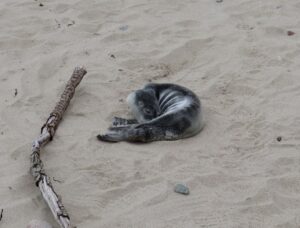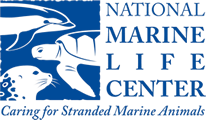Rehabilitation
 Cape Cod is a stranding hotspot. Hundreds of marine animals strand alive and in need of medical care every year. The National Marine Life Center is addressing that need. Our core mission is to rehabilitate for release stranded sea turtles and seals. We believe that through rehabilitation, we can help individual animals, learn more about marine animal species and wildlife disease, and share what we learn to promote ocean conservation.
Cape Cod is a stranding hotspot. Hundreds of marine animals strand alive and in need of medical care every year. The National Marine Life Center is addressing that need. Our core mission is to rehabilitate for release stranded sea turtles and seals. We believe that through rehabilitation, we can help individual animals, learn more about marine animal species and wildlife disease, and share what we learn to promote ocean conservation.
Release
Each patient that is released from our care is equipped with an identification tag of some kind. Seal patients are given flipper tags with a unique number they received while in our hospital, as well as the NMLC contact information. This means that if someone sees any of our past patients, we can be notified. All sea turtles that are admitted to our hospital receive PIT tags. These are injected into the animal and contain unique identification information when scanned. Turtles that are large enough may also be given flipper tags.
Tracking
Selected patients of the National Marine Life Center are equipped with satellite tags so that we can follow their progress in the wild. Learning how these endangered and protected marine animals use the ocean habitat and discovering the post-release behavior of bellwether species provide critical information about them and about the health of the ocean itself.
The Animals We Rehabilitate
As of January 2022, the National Marine Life Center has cared for close to 1,000 threatened, endangered, and/or protected aquatic animals. Our rehabilitation patients and head-start animals to date have included the following species:
- Kemp’s ridley sea turtle (Lepidochelys kempii)
-
- Size: 2 feet; 70-100 pounds at adulthood
- Lifespan: 30 years
- Distribution: Gulf of Mexico and U.S. Atlantic coast
- Most common sea turtle that we triage and rehabilitate
-
- Loggerhead sea turtle (Caretta caretta)
-
- Size: 2.5-3.5 feet; 200-350 pounds at adulthood
- Lifespan: 70+ years
- Distribution: Worldwide in subtropical and temperate regions
- We have taken in loggerheads for long-term rehabilitation
-
- Green sea turtle (Chelonia mydas)
-
- Size: 3-4 feet; 250-400 pounds at adulthood
- Lifespan: 70+ years
- Distribution: Worldwide in subtropical and temperate regions
- We triaged our first green turtle in 2020
-
- Hooded Seal (Cystophora cristata)
-
- Arctic species, migrate further south in the winter
- Size: 7-10 feet; 600-900 pounds at adulthood
- Lifespan: 25-35 years
- Distribution: North Atlantic and Arctic Ocean
- Get their name from a “hood” structure that is similar to the proboscis of an elephant seal
- Males have a nasal membrane, that can inflate and extrude through one nostril in form of a red balloon like structure
- We started rehabilitating hooded seals in 2019
-
- Harp seal (Phoca groenlandica)
-
- Size: 5-6 feet; 260-300 pounds
- Lifespan: 30 years
- Distribution: North Atlantic and Arctic Oceans
- Name comes from a black patch that forms on the backs of adult harp seals that makes the shape of a harp
- We rehabilitate these seals when they migrate here in the winter, sometimes as late as spring
-
- Harbor seal (Phoca vitulina)
-
- Size: 5-6.3 feet; 180-370 pounds
- Lifespan: 25-35 years
- Distribution: North Pacific, North Atlantic, Baltic Sea, and Arctic Ocean
- Resident species: They live in this area year-round
- The most common, widely distributed species of true seals
- We rehabilitate harbor seals all year round
-
- Gray seal (Halichoerus grypus)
-
- Size: 7.5-9 feet; 440-800 pounds
- Lifespan: 25-35 years
- Distribution: North Atlantic and Baltic Sea
- Resident species
- Their scientific name means “hooked-nosed pig of the sea” or “horsehead” since their long noses are so distinctive.
-
- Northern red-bellied cooter (Pseudemys rubriventris)
-
- Size: 10-12 inches; 10 pounds
- Habitat: fresh-water ponds
-
- Diamondback terrapin (Malaclemys terrapin)
-
- Size: females up to 9.8 inches, males up to 5.5 inches
- Habitat: Brackish water – where salt water and freshwater meet
-
What You Can Do For A Stranded Marine Animal

Thank you for caring about sick and injured marine animals, and for wanting to help! Please remember That wildlife can be dangerous and carry diseases. Additionally, animals can be very stressed by human presence. Be sure to stay away from the animal, keep other people, dogs, and seagulls away, and report the animal to the proper authorities. Learn More ›


